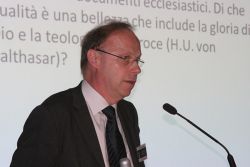Conclusions of the conference
VIII International Liturgical Conference
LITURGY AND ART
The challenge of today's world
Bose, 3-5 June 2010
Monastery of Bose
National Office for the Cultural Heritage of the Church – CEI
CONCLUSIONS OF THE CONFERENCE
1. The conference has shown us that it is necessary to give an exact definition of the central concepts: religious art — sacred/Christian art — liturgical art.
Religious art — art that is not religious: The opposite of religious art is not profane art, but secular art — the negation of all transcendence.
Sacred art — art that is not sacred: Traditional sacred art is in crisis. This has given rise to iconoclasm in modern churches. The question whether it is possible to continue with traditional iconography is open. Herbert Falken, a German painter and theologian, wrote as his eleventh commandment: “You must not make Christian art”.
Liturgical art — art that is not liturgical: There are practical exigencies on the part of the liturgy: the criterion of functionality. Another criterion is that of the place of the work of art in the liturgical space.
2. There must be a distinction between fixed and temporary works of art.
3. There is an awareness of a analogy between liturgy and art on account of their symbolic-sacramental structures.
4. Art can question a liturgy not really celebrated.
5. This gives rise to the question of beauty as mentioned in church documents. Of what quality is beauty that includes God’s glory and the theology of the cross (H.U. von Balthasar)?
6. Some of the examples presented who that a dialogue with great artists of our times helps a great deal in finding convincing solutions and perspectives for the future.
7. The prerequisite for a fruitful dialogue on the part of the Church is and authentic theology and spirituality and a true ars liturgica as primary art.
8. Contemporary art — permanent or temporary — can help towards a better comprehension of traditional art in the church and towards a better performance of the liturgy itself.
9. To overcome the hiatus between the traditional concept of sacred art and the concept of dialogue with contemporary art under the religious aspect it is necessary to study the experience of encounters between church and art that have been successful.
10. There should be an exchange of the experiences of diocesan and national commissions for sacred art and of other venues (for instance, meeting centers, theological faculties) in order to increase sensibility for the artistic dimension. Even an unsuccessful experiment is an occasion for learning.
Albert Gerhards, Universität Bonn
